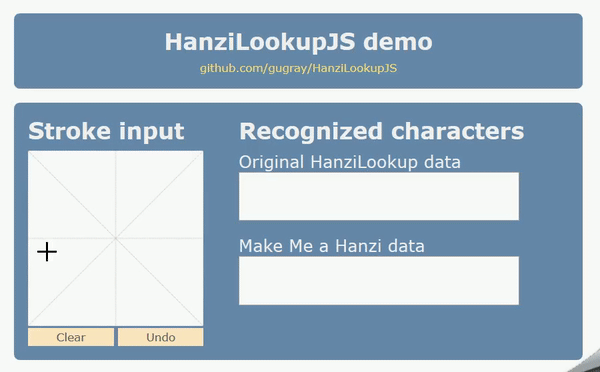HanziLookupJS
Free, open-source Chinese handwriting recognition in Javascript.
The library is based on Jordan Kiang's [HanziLookup] (http://kiang.org/jordan/software/hanzilookup). It contains data derived from Shaunak Kishore's [Make Me a Hanzi] (https://github.com/skishore/makemeahanzi), and an improved character recognition algorithm.
Online demo: https://gugray.github.io/hanzilookupjs
Getting started
You can use the library immediately if you clone the repository, publish it through an embedded server such as Mongoose, and open /demo/index.html in a browser. To use the library in your own application:
-
Include
hanzilookup.min.jsin your page, or bundle it with your application. -
Publish at least one of the data files on your page. These files are not bundled in
hanzilookup.min.jsto avoid blocking page load. The library provides an asynchronous initialization function, which you must call before attempting to recognize characters. The callback function's first argument istrueif the data file loaded successfully, andfalseotherwise. From the demo page:$(document).ready(function () { // Only fetch data (large, takes long) when the page has loaded HanziLookup.init("mmah", "../dist/mmah.json", fileLoaded); HanziLookup.init("orig", "../dist/orig.json", fileLoaded); }); -
If you build your own UI for inputting strokes, then all you need is the code from the demo page's
lookup()function:// Decompose character from drawing board var analyzedChar = new HanziLookup.AnalyzedCharacter(_drawingBoard.cloneStrokes()); // Look up with MMAH data var matcherMMAH = new HanziLookup.Matcher("mmah"); matcherMMAH.match(analyzedChar, 8, function(matches) { // The matches array contains results, best first showResults($(".mmahLookupChars"), matches); }); -
The constructor of
AnalyzedCharactertakes an array of strokes. Every stroke, in turn, consists of an array of points. Every point is a two-dimensional array representing its X and Y coordinates. -
To instantiate
Matcheryou need to pass it the name you chose when callinginit. The matcher is a fairly lightweight object, but you only need one instance throughout your page's lifetime. To look up a new character, just pass theAnalyzedCharacterobject to itsmatchfunction. The second argument specifies how many candidates you want to receive. The callback function returns an array of matches (best first). In each match you're interested in thecharactermember. -
Character lookup is currently synchronous, but a later version of the library will add support for Web Workers and offload the computationally intensive work to a non-blocking thread. Results are returned via a callback function in anticipation of this change.
-
If you choose to use
DrawingBoardfor character input, you need to incude jQuery in your page. The rest of the library has no external dependencies.
The two data files
The file orig.json contains the original data from Jordan Kiang's HanziLookup. Character entries contain the character's stroke count, substroke count, and a pointer into the substroke data. Each substroke is represented by a direction and a normalized length. 10,657 characters are encoded this way, but there are multiple entries for some to account for alternative ways of writing them, resulting in a total of 15,652 entries.
The file mmah.json is derived from Make Me a Hanzi's graphics.txt and encodes 9,507 characters. This file is richer because its substroke data also contains the normalized location (center point) of every substroke. The matching algorithm recognizes at runtime that this information is non-zero and calculates the score accordingly: a substroke that is in the wrong place counts for less.
The conversion tool is a .NET Core application, included in the /mmah-convert subfolder. To repeat the conversion, you need to place graphics.txt from the MMAH repository in the /work subfolder.
Both data sets store substroke descriptors in an ArrayBuffer, Base64-encoded in the JSON file. Each substroke is represented by 3 bytes: (1) Direction in radians, with 0-2*PI normalized to 0-255; (2) Length normalized to 0-255, where 255 is the bounding square's full width; (3) Centerpoint X and Y, both normalized to 0-15, with X in the 4 higher bits.
License
This Javascript library is derived from Jordan Kiang's original HanziLookup. In compliance with the original, it is licensed under GNU LGPL. This license covers both the code and the original data in orig.json.
The data in mmah.json is ultimately derived from the following fonts, via Make Me a Hanzi's graphics.txt:
- Arphic PL KaitiM GB - https://apps.ubuntu.com/cat/applications/precise/fonts-arphic-gkai00mp/
- Arphic PL UKai - https://apps.ubuntu.com/cat/applications/fonts-arphic-ukai/
You can redistribute and/or modify mmah.json under the terms of the Arphic Public License as published by Arphic Technology Co., Ltd. The license is reproduced in LICENSE-APL; you can also find it online at http://ftp.gnu.org/non-gnu/chinese-fonts-truetype/LICENSE.
